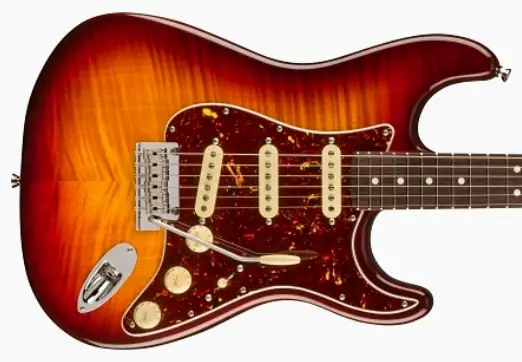Demystifying the Fender Precision Bass: A Deep Dive into the Iconic P-Bass
What is a P Bass? Introduced in 1951 by Leo Fender, the Fender Precision Bass, also known as the P Bass, revolutionized the music world by becoming the first commercially successful electric bass guitar. The P Bass quickly gained popularity among bassists worldwide and continues to be one of music’s most iconic and enduring instruments.
It was designed to address the need for a more reliable and versatile bass instrument that could provide a solid low-end foundation to the music, and its innovative construction and superior sound quality quickly made it a preferred choice for bass players across various genres.
Table of Contents
What is a P Bass, or What makes a P Bass
Origins and Design
In 1951, Leo Fender introduced the Precision Bass, also known as the P-Bass, to the world of music. This revolutionary instrument was explicitly designed to address the limitations of the double bass, which was the standard instrument at the time.
The P-Bass was created to provide a more practical and versatile alternative to the double bass. The double bass was a large and heavy instrument, making it difficult to transport and play for extended periods. Additionally, it was challenging to amplify its sound, as the instrument’s acoustic sound was not loud enough to cut through the mix of other instruments in a band.
Leo Fender designed the P-Bass with a solid body construction to overcome these limitations, allowing for more accessible transport and amplification. The fretted fingerboard of the P-Bass was also a significant development, as it qualified for precise intonation, making it easier for bass players to play in tune with the rest of the band.
The solid body construction of the P-Bass also significantly impacted the instrument’s sound. The solid body allowed for more sustain and a clearer, punchier tone, making it easier for the bass to cut through the mix of other instruments. This was especially important in the emerging genres of rock and roll and rhythm and blues, where the bass played a crucial role in defining the sound of the music.
Overall, the birth of the P-Bass in 1951 was a significant milestone in the history of bass instruments. Leo Fender’s innovative design addressed the limitations of the double bass, providing a more practical and versatile alternative that forever changed the sound of popular music.

Key Features
To fully appreciate the distinctive tone of a P-Bass, it is essential to understand the contribution of its single split-coil pickup. Unlike other bass guitars available in the market, the P-Bass can produce a unique blend of clarity, warmth, and punchiness that sets it apart. It is because of the innovative split-coil design of the pickup, which essentially divides the string signal into two halves. This results in reduced hum and noise interference, allowing the pickup to produce a rich, full-bodied sound that is perfect for various genres of music.
Moving on to the neck of the P-Bass is a one-piece, 20-fret maple neck designed for maximum playability. The maple wood used in the construction of the neck provides a smooth, fast-playing surface that is perfect for both beginners and experienced players alike. The slim neck profile ensures that players can quickly move their hands up and down the fretboard, allowing them to precisely play intricate bass lines and fast-paced solos.
Regarding the body woods used in constructing the P-Bass, there are four popular options: alder, ash, Poplar, and basswood. Each of these woods has its unique tonal characteristics, which can significantly impact the overall sound of the bass guitar. Alder, for instance, is known for its balanced tone, while ash is preferred for its bright, punchy sound. On the other hand, Poplar is a more affordable option that produces a warm, mellow sound. Basswood is known for its deep, resonant tone.
Lastly, the P-Bass offers a range of hardware and color options, including different bridge types, pickup configurations, and finishes. The bridge types available include the traditional vintage-style and modern high-mass bridges. At the same time, the pickup configurations range from the standard single-coil pickup to the more versatile dual-coil humbucker pickup. As for finishes, several options are available, including classic sunburst, sleek black, and eye-catching metallic colors.
Influence on Music
The Precision Bass, also known as P-Bass, is an iconic electric bass guitar that has played an instrumental role in shaping popular music genres since its inception in 1951. Leo Fender created the instrument, and it has since become a go-to choice for bass players worldwide.
One of the unique features of the Precision Bass is its design, which provides players with a more accurate and consistent sound. The instrument’s split-coil pickup and solid-body construction give it a distinct tone that can be heard across various music styles.
Over the years, many legendary musicians have embraced the P-Bass, including jazz bassist Monk Montgomery and Elvis Presley’s bassist Bill Black. The instrument has been used in various music genres, from jump blues and swing to rhythm and blues, rock, soul, and funk.
Overall, the Precision Bass remains a crucial component of contemporary music, and its contribution to the evolution of music cannot be overstated. Its versatility, reliability, and exceptional sound quality make it popular among bass players worldwide.
The Legacy of James Jamerson Precision Bass
Evolution and Variants
Post-1957 Configurations: Since the introduction of the Precision Bass in 1951, Fender has made numerous changes and improvements to its configuration over the years. The post-1957 configurations of the P-Bass include:
- A split-coil pickup.
- A contoured body for added player comfort.
- Various finishes and color options.
Jazz Bass Influence: In 1960, Fender introduced the Jazz Bass, which featured two single-coil pickups and a slim neck profile. The Jazz Bass quickly became popular among bassists, and its influence can be seen in the “PJ” configuration, which combines a Precision Bass split-coil pickup with a Jazz Bass single-coil pickup.
Legacy and Imitation: The Precision Bass remains one of the most influential bass guitars ever, and countless manufacturers have imitated its sound and design. Its legacy can be attributed to its versatility, durability, and iconic tone, which has been heard on countless recordings across numerous genres. The P-Bass is also favored by many bassists for its simplicity and ease of use, making it an ideal choice for both beginner and professional players.
In conclusion, the Precision Bass, commonly known as P-Bass, has significantly shaped music history. Its introduction in the 1950s marked a turning point in the development of bass guitars, as it was the first instrument to feature frets that allowed for a more precise and consistent sound. The P-Bass quickly gained popularity among musicians, particularly in rock and roll, country, and funk, and became a staple instrument in countless recordings and live performances.
Today, over 70 years after its inception, the P-Bass is a highly sought-after and respected instrument, loved for its versatility, clarity, and power. Its influence can be heard in the music of countless artists, from James Jamerson and Carol Kaye to Sting and Flea. As such, it is safe to say that the P-Bass has left an indelible mark on music history, and its legacy will undoubtedly continue to inspire generations of musicians to come.
So, what is a P Bass:
Here are some key features that make a P Bass (Fender Precision Bass) unique:
| Feature | Description |
|---|---|
| Origin | It is known for its deep, resonant tone with a natural roundness. |
| Design Evolution | The Fender Precision Bass first appeared in 1951 and was the first electric bass guitar to gain significant attention and usage. |
| Tone | It is known for its deep, resonant tone with a natural roundness. |
| Frets | It is known for its deep, resonant tone that has a natural roundness to it. |
| Body Type | It is known for its deep, resonant tone with a natural roundness. |
| Neck Joint | Bolt-on. |
| Woods Used | Body: Alder, Ash, Poplar, Basswood. Neck: Maple. Fretboard: Maple, Rosewood, Pau Ferro, Ebony. |
| Pickups | It is known for its deep, resonant tone with a natural roundness. |
| Scale Length | 34 inch. |
| Fingerboard Length | 24 inch. |
| Nut Width | 1-11/16 inch. |
| Frets | Usually, one two-piece split-coil humbucker. |
These features contribute to the P Bass’s bold, punchy tone and precision, making it a timeless classic in the music world.
References:


